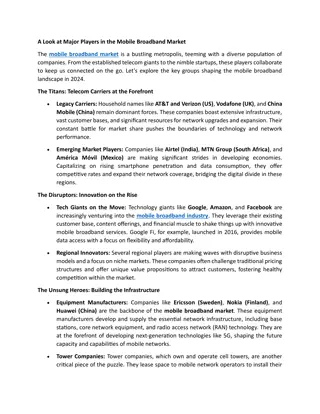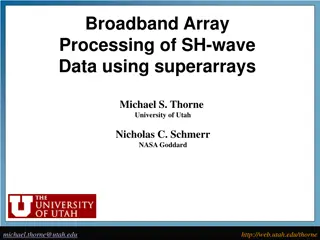Broadband Initiatives and Access Across Georgia and Other States
Georgia and other states are working towards improving broadband accessibility, with Georgia ranking 19th overall and 14th in rural broadband access. The state is implementing initiatives such as school broadband programs and grants for last-mile connectivity. Tennessee, ranked 29th overall, is also making efforts through Connected Tennessee, aiming to accelerate technology use through strategic partnerships. Understanding the broadband landscape and initiatives across different states is crucial for addressing connectivity challenges and enhancing digital infrastructure.
Download Presentation

Please find below an Image/Link to download the presentation.
The content on the website is provided AS IS for your information and personal use only. It may not be sold, licensed, or shared on other websites without obtaining consent from the author. Download presentation by click this link. If you encounter any issues during the download, it is possible that the publisher has removed the file from their server.
E N D
Presentation Transcript
Georgia and Other State Broadband Initiatives Blake Doss, House Budget and Research Office
Broadband Overview Federal Communications Commission (FCC) defines broadband as 25/3 megabits per second (Mbps). Georgia s broadband definition in Code from 2006 is 200 kilobits per second (Kbps).1 For comparison, internet speed at the Capitol averages 60 Mbps. Fiber optic cable can cost up to $40,000 per mile in rugged areas.
Broadband Accessibility by State2 State National Rank Rural Rank North Carolina 15 11 Florida 16 17 Georgia 19 14 Tennessee 29 19 Kentucky 35 20 South Carolina 39 26 Alabama 42 28 Arkansas 46 32 Mississippi 51 41
Broadband in Georgia GA ranks 19thoverall and 14thfor providing fixed broadband access in rural areas. o Estimated 932,484 individuals statewide (9%) without access to 25/3 Mbps. o Estimated 626,070 individuals (25%) in rural areas without access to 25/3 Mbps. 108 rural counties in Georgia, defined as a population of 35,000 or less.3 Statute doesn t limit wired municipal broadband. EMCs are technically not prohibited from providing broadband, but there is no Code provision allowing them to provide it, either. 2013 industry study shows the state receives $33 million in sales tax from telecommunications equipment.
Georgia Broadband School Initiatives Connections for Classrooms o $77 million in competitive grants to local systems in bond funds and state general funds to complete the last mile. 159 school districts were awarded grant funds in FY 2014 through FY 2016. o Leveraged $129 million in federal e-rate funds for school network infrastructure. o In cooperation with the expansion of the University System of Georgia s PeachNet network, these funds ensured all school districts have 100 mbps of broadband connectivity to each school by July 2015. o $4 million in one-time Digital Learning Device Rural Grant Program enabling rural, high-need districts that are implementing digital learning to purchase laptops, tablets, or other notable devices used for instruction. 33 rural, high-need school districts were awarded grant funds in FY 2017.
Tennessee (29thoverall; 19thrural) 13% of Tennesseans are without access to 25/3 Mbps. Connected Tennessee, an independent non-profit, was established in 2007.4 o Aims to accelerate the availability and use of technology by coming up with statewide strategies. o The state established a steering committee under Connected Tennessee comprised of public and private partners to provide an environment for interactions. o Partners with businesses, universities and government entities to map broadband infrastructure and provide a forum for interaction.
Tennessee (29thoverall; 19thrural) SB 1215, the Tennessee Broadband Accessibility Act, enacted in 2017.5 The bill allows EMCs to provide broadband. It also provides a $45 million incentive program: o Franchise and excise tax credit of 6% for the purchase of qualified equipment. Up to $5 million per year over next three years. o Grant program under Economic and Community Development Department. $10 million per year over next three years. Priority given to areas without 10 Mbps/1 Mbps.
Chattanooga Municipal Efforts In 2010, Chattanooga became the first city to offer one gigabit speeds. Electric Power Board, the city s municipal power company, began the project in 2007, while modernizing its grid. The network has generated an economic impact over $865 million. Cost: About $220 million, with $111 million in stimulus money from the federal government.6
Kentucky (35thoverall; 20thrural) 16% of Kentuckians are without broadband access. The Department for Local Government was ordered to track the deployment and adoption of broadband in 2010. o Enable public-private partnerships between providers and government entities. o Serve as the resource for all citizens and business on broadband. o Make annual report to Legislative Research Commission. o Ensure notification of public funds for broadband prior to awarding grants.7
Kentucky (35thoverall; 20thrural) KentuckyWired, statewide middle-mile project began in 2015. o Macquarie Capital, Australian company, is on a 30-year contract to run the project. o Also entered into agreements with local entities to build spurs. The state is using $270 million in tax-exempt bonds and $30 million in appropriations to build the network. The network is located in all 120 counties by building dark fiber to government and higher education hubs. It is an 85% aerial network; pole attachment agreements can cause delays.8
Kentucky (35thoverall; 20thrural) The Kentucky Communications Network Authority oversees KentuckyWired and offers access to entities to utilize excess capacity. It is under the governor s authority. Providers will need to connect to the network and provide the last-mile. Completion is expected by 2018, with speeds starting around 100 Mbps.9
North Carolina (15thoverall; 11thrural) 7% of North Carolina residents are without broadband access. Pending legislation: HB 639 appropriates $900,000 to the Department of Information Technology for the next two years. o $50,000 given to each of 16 regional Councils of Government (COG) each year to provide technical assistance in economic and community development, along with broadband deployment for unserved and underserved rural areas. o COGs shall use the money to develop plans in cooperation with providers and local governments. o Progress reports are required.10
North Carolina (15thoverall; 11thrural) An Industrial Development Fund Utility Account was created within the Department of Commerce to provide funds to economically distressed counties to create jobs. o Money can be used to improve or construct water, sewer, gas, broadband, or other critical infrastructure.11 The Rural Economic Development Division administers grants/loans awarded by Rural Infrastructure Agency. o Priority given to highest ranking 80 counties in tier system. o Can be used for critical infrastructure, including broadband. o Grants can t exceed $12,500 per projected job created or saved. 12
Florida (16thoverall; 17thrural) 7% of Floridians are without broadband access. Pending legislation: HB 687 states an authority can t prohibit, regulate, or charge for the collocation of small wireless facilities in public rights-of-way, except for what is specified in the bill. 13 o The bill excludes DOT rights-of-way. o The bill excludes municipal electric utility poles.
Arkansas (46thoverall; 32ndrural) 25% of Arkansas residents are without broadband access. The Arkansas Broadband Council was created in 2007 to monitor broadband initiatives in other states and receive input from providers to advise the governor and general assembly.14 In 2009, the state decided that all county economic development plans shall be given priority if they include regional broadband collaborations. o Also, the state allowed the use of their High Cost Fund (like our UAF) to provide grants, etc.15
Oklahoma (48thoverall; 49thrural) 27% of Oklahoma residents are without broadband access. Oklahoma State University starts their mobile hot spot pilot program in June. o Copied from Kansas. Four libraries are given four devices to check out. o They cost about $200 each for one year subscriptions. The OSU Extension Office is paying for it this year, but libraries will have to foot the bill if they want the program to continue.16
New York (3rdoverall; 8thrural) 2% of New York residents are without broadband access, which places the state as third overall in the nation. Governor Cuomo announced a $500 million grant program with three phases in 2015. o It is mostly funded through the PSC s approval of the merger of Time Warner and Charter Communications. It features a reverse-auction process when awarding bids, with the RFP process occurring within the RDCs to ensure statewide funding allocation. Goal: To make sure everyone has broadband by 2018. o At least 25 Mbps in remote areas and 100 Mbps everywhere else.17
Works Cited 1. 2. 3. 4. 5. 6. O.C.G.A. 46-5-221 https://apps.fcc.gov/edocs_public/attachmatch/FCC-16-6A1.pdf 1999 Rural Hospital Assistance Act; O.C.G.A 31-7-94.1(c)(3) http://www.connectedtn.org/ http://wapp.capitol.tn.gov/apps/BillInfo/Default.aspx?BillNumber=SB1215&GA=110 https://www.thenation.com/article/chattanooga-was-a-typical-post-industrial-city-then-it-began- offering-municipal-broadband/ Kentucky Code 147A.023 Doug Hendrix, general counsel for Kentucky Communications Network Authority http://kentuckywired.ky.gov/about/Pages/default.aspx http://www.ncga.state.nc.us/Sessions/2017/Bills/House/PDF/H639v0.pdf North Carolina Code 143B-437.01 North Carolina Code 143B-472.127 https://www.flsenate.gov/Session/Bill/2017/687/Analyses/h0687z.EUS.PDF Arkansas Code 4-113-104 Arkansas Code 4-113-105 Brian Whitacre, OSU https://www.governor.ny.gov/news/governor-cuomo-launches-third-round-new-ny-broadband- program 7. 8. 9. 10. 11. 12. 13. 14. 15. 16. 17.























